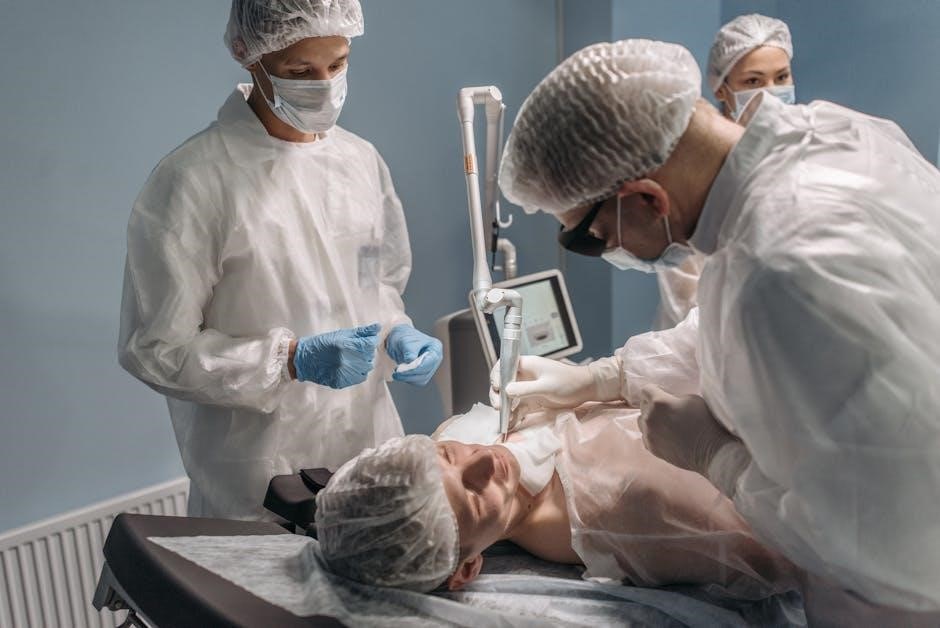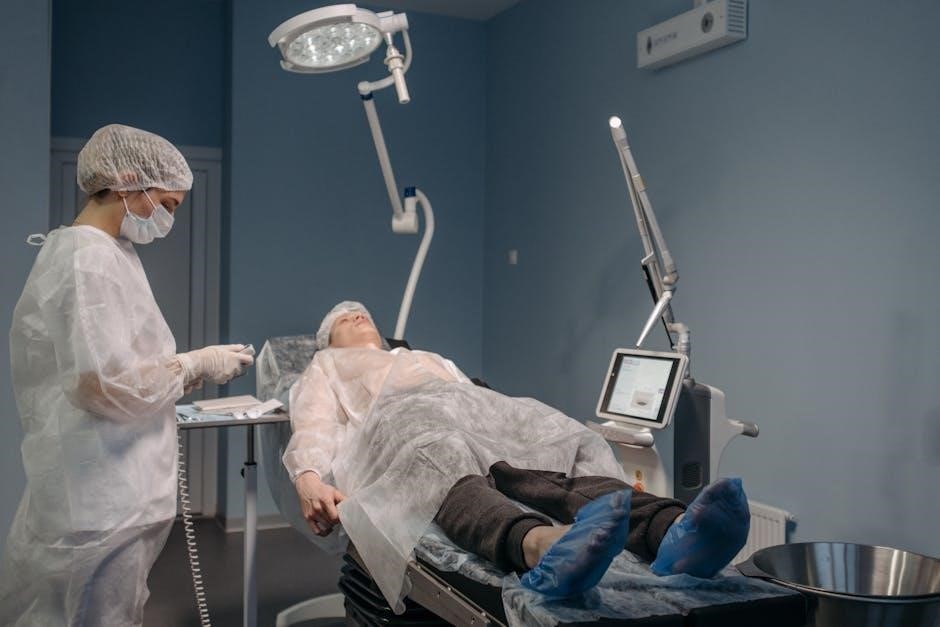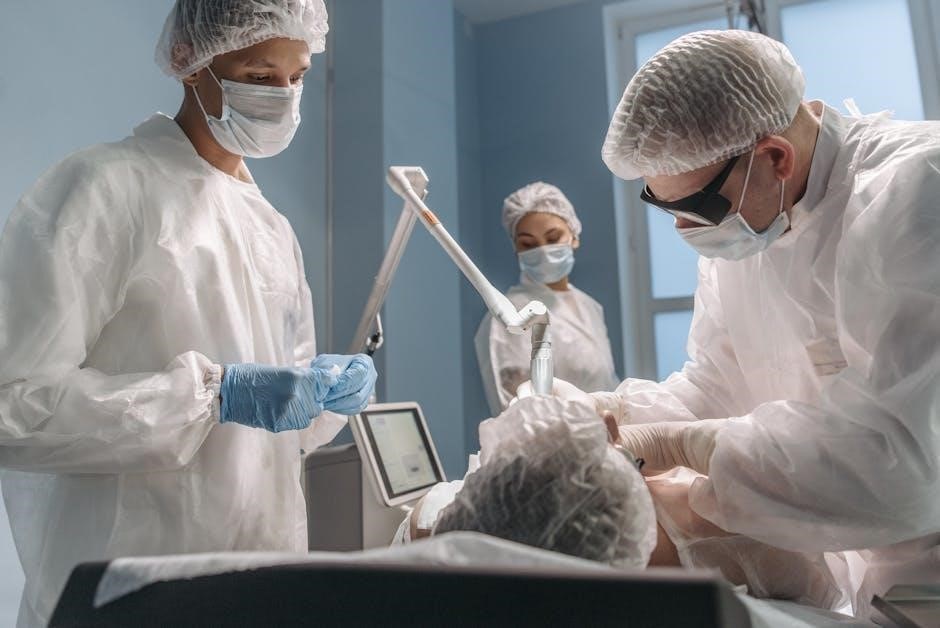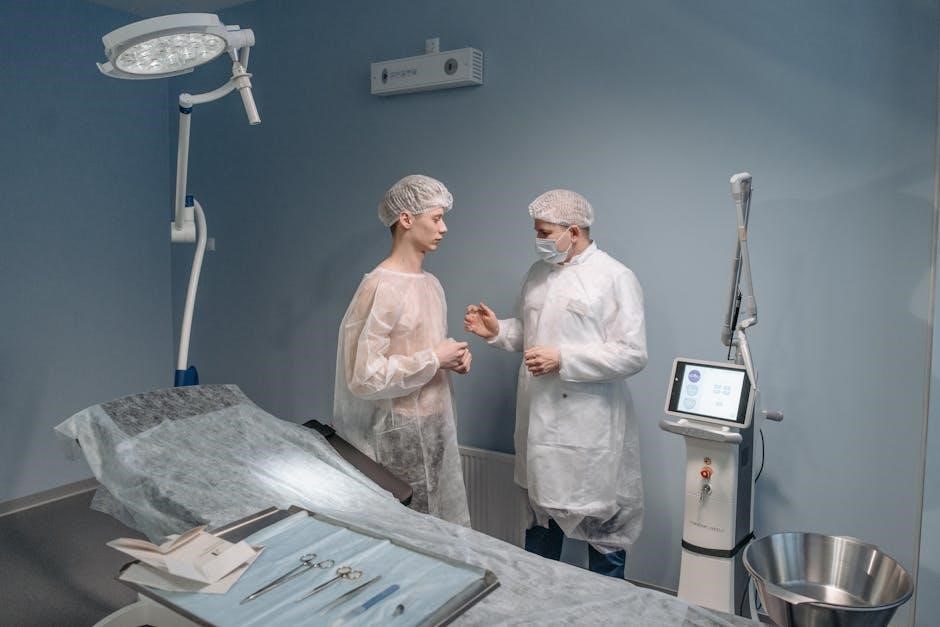Cataract surgery restores vision by removing a cloudy lens‚ offering two main approaches: laser-assisted and manual. Both methods aim to improve vision clarity but differ in technique and benefits.
What Are Cataracts?
Cataracts are a clouding of the lens in the eye‚ which leads to blurred or dim vision. This condition occurs when proteins in the lens clump together‚ reducing light transmission and causing vision problems; Cataracts are most commonly associated with aging but can also result from injuries‚ medications‚ or health conditions like diabetes. Symptoms include blurry vision‚ difficulty with glare‚ and trouble seeing at night. If left untreated‚ cataracts can severely impair daily activities‚ such as reading or driving. While cataracts are a natural part of aging for many‚ advancements in surgical techniques now offer effective solutions to restore clear vision. Understanding cataracts is essential for exploring treatment options like laser and manual cataract surgery.
Overview of Cataract Surgery
Cataract surgery is a medical procedure designed to restore vision by removing the cloudy lens and replacing it with an artificial intraocular lens (IOL). It is a highly effective treatment for cataracts‚ offering significant improvement in vision clarity and quality of life. The surgery can be performed using two primary methods: laser-assisted or manual techniques. Both approaches aim to remove the cloudy lens and implant a customized IOL to correct vision. The procedure is typically quick‚ performed on an outpatient basis‚ and involves minimal downtime. Cataract surgery is a life-changing intervention that helps patients regain independence and enjoy activities they once found challenging due to vision loss. By addressing the root cause of vision impairment‚ it provides long-term benefits and enhanced optical clarity.
Importance of Cataract Surgery
Cataract surgery is a vital medical intervention that significantly improves vision and quality of life for millions of people worldwide. By removing the cloudy lens and replacing it with an intraocular lens (IOL)‚ the procedure restores clarity‚ color perception‚ and optical accuracy. This surgery is not just about correcting vision; it also enhances overall well-being by allowing individuals to perform daily tasks‚ drive safely‚ and engage in activities they previously found challenging. Additionally‚ addressing cataracts can reduce the risk of falls and related injuries‚ improving safety and independence. Cataract surgery is a life-changing procedure that offers long-term benefits‚ making it a cornerstone in ophthalmology for treating this common condition effectively.

Understanding Laser Cataract Surgery
Laser cataract surgery uses advanced femtosecond laser technology for precise incisions and capsulotomies‚ offering customization and reduced manual intervention‚ enhancing accuracy and improving surgical outcomes significantly.
What is Laser Cataract Surgery?
Laser cataract surgery is an advanced surgical procedure that utilizes femtosecond laser technology to perform precise incisions‚ capsulotomies‚ and lens fragmentation. This method minimizes manual intervention‚ enhancing accuracy and customization. The laser creates a circular opening in the lens capsule and breaks up the cataract into smaller pieces‚ which are then removed using phacoemulsification. This technology allows for tailored treatment‚ improving the consistency of outcomes. Surgeons can program the laser to match the patient’s specific eye measurements‚ reducing human error. While the laser performs the initial steps‚ the surgeon completes the procedure by implanting the intraocular lens; This blend of automation and surgical expertise aims to optimize vision restoration and reduce recovery time‚ making it a popular choice for patients seeking precise and minimally invasive cataract correction.
How Laser Cataract Surgery Works
Laser cataract surgery begins with the creation of a precise incision in the cornea using a femtosecond laser. The laser then performs a capsulotomy‚ creating a circular opening in the lens capsule. Next‚ the laser fragments the cataractous lens into smaller‚ manageable pieces. This step enhances the efficiency of the subsequent phacoemulsification process. The surgeon then uses ultrasonic waves to break down and remove the lens fragments. Finally‚ an intraocular lens (IOL) is implanted to restore vision. The laser’s precision reduces manual intervention‚ allowing for more accurate incisions and consistent outcomes. This method minimizes surgical variability‚ offering a high level of customization based on the patient’s unique eye anatomy‚ thereby optimizing the surgical experience and recovery process.
Advantages of Laser Cataract Surgery
Laser cataract surgery offers enhanced precision and accuracy compared to manual methods. The femtosecond laser creates precise incisions and fragments the cataract‚ reducing reliance on manual techniques. This minimizes human error and ensures consistent results. Laser surgery also allows for customized treatment‚ with advanced imaging guiding the procedure for optimal outcomes. The reduced use of ultrasound energy during phacoemulsification minimizes trauma to the eye‚ promoting faster healing. Additionally‚ laser-assisted surgery often results in smaller incisions‚ reducing recovery time and lowering the risk of complications. Patients may experience improved visual clarity and fewer side effects‚ such as astigmatism or inflammation. Overall‚ laser cataract surgery combines advanced technology with surgical expertise‚ offering a safer‚ more predictable‚ and visually superior outcome for many patients‚ making it a preferred choice for those seeking modern‚ minimally invasive care.
Cost Considerations for Laser Cataract Surgery
Laser cataract surgery is generally more expensive than manual surgery due to the advanced technology and equipment involved. The cost includes the femtosecond laser‚ which adds to the overall expense. Patients may need to pay out-of-pocket for laser surgery if insurance does not cover the additional fees. Factors such as the surgeon’s experience‚ facility charges‚ and geographic location also influence the total cost. While laser surgery offers precision and reduced complications‚ the higher price may not be justified for all patients‚ as manual surgery often achieves similar outcomes at a lower cost. Patients should discuss their budget and insurance coverage with their surgeon to determine if laser surgery aligns with their financial situation and priorities.
Who is a Good Candidate for Laser Cataract Surgery?
Patients with cataracts who are seeking precise‚ minimally invasive surgery may benefit from laser cataract surgery. Ideal candidates include those with mild to moderate cataracts‚ as advanced cases may require manual intervention. Individuals with astigmatism or those opting for premium intraocular lenses (IOLs) often prefer laser surgery for its ability to correct refractive errors. Additionally‚ patients with certain corneal conditions or those seeking reduced reliance on glasses post-surgery are good candidates. However‚ individuals with severe eye diseases or irregular corneal shapes may not be suitable. Ultimately‚ the decision should be made after a comprehensive eye exam and consultation with an ophthalmologist to determine the best approach based on the patient’s unique needs and preferences.

Understanding Manual Cataract Surgery
Manual cataract surgery‚ or phacoemulsification‚ involves ultrasonic waves breaking up the lens‚ which is then removed and replaced with an intraocular lens (IOL). It remains a reliable‚ widely-used method.
What is Manual Cataract Surgery?
Manual cataract surgery‚ also known as phacoemulsification‚ is a traditional procedure where the surgeon uses ultrasonic waves to break up the cloudy lens‚ which is then suctioned out. A small incision is made in the cornea‚ allowing access to the cataract. The lens is emulsified and removed‚ and an intraocular lens (IOL) is implanted to restore vision. This technique has been refined over decades and is considered safe and effective‚ with a high success rate. It requires precise manual dexterity from the surgeon‚ making it a reliable option for many patients.
How Manual Cataract Surgery Works
Manual cataract surgery begins with numbing the eye to ensure patient comfort. A small incision is made in the cornea‚ and the cloudy lens is accessed. Using ultrasonic waves‚ the lens is broken into smaller pieces‚ which are then gently suctioned out through the incision; The remaining lens capsule is left intact to support the intraocular lens (IOL)‚ which is implanted to restore vision. The procedure relies on the surgeon’s precision and skill to manually navigate the eye’s delicate structures.
The surgery typically takes about 15-20 minutes per eye‚ with minimal discomfort for the patient. Post-surgery‚ the eye heals naturally‚ and vision gradually improves. While effective‚ manual surgery depends heavily on the surgeon’s expertise‚ making it a trusted yet technique-dependent option for cataract correction.
Advantages of Manual Cataract Surgery
Manual cataract surgery offers several advantages‚ including its cost-effectiveness and widespread availability. It is a well-established procedure with a long history of successful outcomes‚ making it a reliable choice for patients. The surgery is less dependent on advanced technology‚ allowing it to be performed in a variety of clinical settings. Additionally‚ manual techniques often result in faster recovery times compared to more complex procedures. Surgeons typically have extensive experience with this method‚ which can lead to better precision in challenging cases. The lack of reliance on laser technology also reduces the risk of equipment-related complications. Overall‚ manual cataract surgery remains a popular and effective option for addressing cataracts‚ providing clear vision restoration with minimal downtime.
Cost Considerations for Manual Cataract Surgery
Manual cataract surgery is generally more affordable compared to laser-assisted surgery. The absence of expensive laser technology reduces overall costs‚ making it a cost-effective option for many patients. Insurance coverage often applies‚ further lowering out-of-pocket expenses. However‚ while the procedure itself is cheaper‚ post-operative care and medications may add to the total cost. Additionally‚ the cost can vary depending on the surgeon’s experience and the facility. Despite these factors‚ manual surgery remains a budget-friendly choice without compromising on the quality of outcomes. Patients should consult with their healthcare provider to understand the specific financial aspects of their procedure.
Who is a Good Candidate for Manual Cataract Surgery?
Manual cataract surgery is suitable for most individuals with cataracts‚ particularly those seeking an affordable and reliable option. It is ideal for patients with straightforward cataracts and no significant eye diseases. Those who do not require precise laser-guided incisions or have mild cataracts may benefit from this traditional method. Additionally‚ individuals with limited financial resources or no insurance coverage often opt for manual surgery due to its lower cost. Patients with dense cataracts or specific corneal conditions may also find manual surgery more appropriate. However‚ individuals with high expectations for precision or those seeking minimal post-operative recovery time might prefer laser surgery. Ultimately‚ the decision should be made in consultation with an eye surgeon‚ who will assess the patient’s unique needs and recommend the most suitable option.

Comparing Laser and Manual Cataract Surgery
Laser and manual cataract surgeries differ in technique‚ cost‚ and precision. Laser offers automated accuracy‚ while manual is cost-effective with proven outcomes‚ catering to diverse patient needs.
Accuracy and Precision in Both Methods
Laser cataract surgery offers high precision‚ utilizing advanced technology to create precise incisions and fragment the lens. This reduces human error and enhances consistency. In contrast‚ manual surgery relies on the surgeon’s skill and experience‚ which can also achieve excellent results but may vary slightly between surgeons. While both methods are effective‚ laser surgery provides measurable accuracy‚ particularly in complex cases. However‚ skilled surgeons can match laser precision in manual procedures‚ making both techniques reliable. The choice often depends on the patient’s specific needs and the surgeon’s recommendation‚ ensuring optimal outcomes in either approach. Both methods have proven to deliver accurate and precise results‚ contributing to successful cataract removal and vision restoration.
Recovery Time: Laser vs. Manual
Recovery time varies slightly between laser and manual cataract surgery‚ with both methods offering relatively quick healing. Laser-assisted surgery often results in reduced inflammation and faster stabilization of vision due to its precise incisions. Patients typically experience minimal discomfort and can resume daily activities within a few days. Manual surgery‚ while also effective‚ may require a slightly longer healing period‚ as the incisions are larger and may take more time to seal. However‚ advancements in manual techniques have significantly improved recovery times‚ making both methods comparable in terms of overall healing. Ultimately‚ both approaches lead to excellent visual outcomes‚ with the primary difference being the speed of initial recovery and comfort during the healing process.
COST Comparison: Laser vs. Manual
The cost of laser-assisted cataract surgery is generally higher than manual surgery due to the advanced technology and equipment involved. Laser systems require significant investment‚ which is often passed on to patients. Manual cataract surgery‚ being a more traditional and widely practiced method‚ typically has lower associated costs. However‚ the final price can vary depending on factors such as the surgeon’s expertise‚ location‚ and the specific techniques used. Insurance coverage may also play a role‚ as some policies may cover manual surgery more comprehensively than laser-assisted procedures. While laser surgery offers precision and potential long-term benefits‚ patients should weigh these advantages against the higher upfront cost. Ultimately‚ the choice may depend on individual financial circumstances and priorities.
Complications and Risks: Laser vs. Manual
Both laser and manual cataract surgeries carry potential complications‚ though they are generally safe. Laser-assisted surgery may pose risks such as capsular rupture‚ dry eye‚ or corneal abrasion due to the laser’s precision and energy use. Manual surgery‚ while effective‚ may involve risks like posterior capsule opacification‚ intraocular inflammation‚ or intraoperative complications from the surgeon’s technique. In rare cases‚ both methods can result in retinal detachment or intraocular lens (IOL) dislocation. The choice between laser and manual surgery should consider individual risk factors‚ such as pre-existing eye conditions or overall health. While laser surgery offers precision‚ manual surgery’s lower complexity may reduce certain risks. Ultimately‚ both methods are safe‚ but the specific risks vary‚ and a thorough discussion with a surgeon is essential to determine the best option for each patient.
Patient Satisfaction: Laser vs. Manual
Patient satisfaction levels for both laser and manual cataract surgeries are generally high‚ but differences exist. Laser-assisted surgery often results in quicker visual recovery and reduced dependence on glasses post-operatively‚ enhancing patient satisfaction. Many patients report sharper vision and fewer halos or glare‚ contributing to higher satisfaction rates. On the other hand‚ manual surgery‚ while effective‚ may have a slightly longer recovery period. However‚ advancements in manual techniques have improved outcomes‚ with patients frequently expressing satisfaction with their improved vision. Overall‚ both methods yield positive results‚ but individual preferences and expectations play a significant role in determining satisfaction. Patients should discuss their lifestyle and visual goals with their surgeon to choose the most suitable option for optimal satisfaction.

Outcomes and Results
Both laser and manual cataract surgeries yield effective results‚ restoring vision clarity. Laser may offer enhanced precision‚ while manual techniques remain highly successful‚ with outcomes influenced by surgical expertise.
Visual Outcomes: Laser vs. Manual
Both laser and manual cataract surgeries deliver excellent visual results‚ with studies showing minimal differences in final vision clarity. However‚ laser-assisted surgery often provides greater precision in incisions and lens placement‚ potentially reducing astigmatism. Manual surgery‚ while highly effective‚ relies more on the surgeon’s skill and experience. Patients in both groups typically achieve significant improvement in vision‚ though laser may offer slightly better refractive outcomes. Ultimately‚ the choice between methods should consider individual eye anatomy and surgeon recommendation. Both techniques aim to restore clear vision‚ with outcomes largely dependent on proper patient selection and surgical expertise.
Patient Experience: Laser vs. Manual
Patient experience differs slightly between laser and manual cataract surgery‚ though both methods are generally well-tolerated. Laser-assisted surgery often provides a more precise and predictable experience‚ with less manual intervention‚ which may reduce discomfort during and after the procedure. Patients undergoing laser surgery frequently report minimal pain and a faster return to normal activities. Manual surgery‚ while equally effective‚ may involve a slightly longer recovery time and more post-operative care. Satisfaction rates are high in both groups‚ with patients typically experiencing significant improvement in vision. The choice between the two often depends on individual preferences and specific eye conditions. Both methods aim to ensure a safe and comfortable experience‚ with advancements in technology and technique continually enhancing patient outcomes. Ultimately‚ the goal is to restore clear vision with minimal disruption to daily life.
Long-Term Benefits: Laser vs. Manual
The long-term benefits of laser and manual cataract surgery are comparable‚ with both methods aiming to restore clear vision and improve quality of life. Laser-assisted surgery may offer reduced risk of long-term complications due to its precision‚ potentially leading to more stable outcomes. Manual surgery‚ while highly effective‚ may carry slightly higher risks of astigmatism or refractive errors over time. Both techniques result in lasting vision improvement‚ with patients typically enjoying reduced dependency on glasses. The choice between laser and manual often depends on individual eye conditions and surgeon recommendations. Ultimately‚ both methods provide safe and durable solutions for cataract treatment‚ ensuring long-term visual clarity and enhanced daily functioning. The advancements in both techniques continue to improve patient outcomes‚ making either option a viable choice for lasting vision correction.
Future of Cataract Surgery
Advancements in laser technology promise enhanced precision‚ while manual techniques evolve for efficiency. The integration of both methods may offer personalized‚ optimal outcomes for patients.
Advancements in Laser Technology
Recent advancements in laser technology have significantly improved the precision and safety of cataract surgery. Newer laser systems offer enhanced imaging capabilities‚ allowing for more accurate incisions and lens fragmentation. These innovations reduce the reliance on manual techniques‚ minimizing human error. Additionally‚ custom laser settings can now be tailored to individual patient needs‚ optimizing outcomes. Emerging technologies‚ such as femtosecond lasers‚ are being refined to improve corneal incisions and reduce healing time. These developments are making laser cataract surgery more accessible and efficient‚ while maintaining high success rates. As technology continues to evolve‚ laser-assisted procedures are expected to become even more prevalent‚ offering patients improved visual results with fewer complications.
Evolution of Manual Surgical Techniques
Manual cataract surgery has undergone significant refinements over the years‚ with phacoemulsification remaining the cornerstone of modern techniques. Originally developed in the 1960s‚ this method has evolved to minimize invasiveness and improve outcomes. Advances in surgical instrumentation‚ such as micro-incisional techniques‚ have reduced healing times and lowered complication rates. Surgeons now use highly precise tools and refined strategies to remove cataracts more efficiently. While laser-assisted surgery offers precision‚ manual techniques remain highly effective and widely used‚ particularly in cases where laser technology is unavailable. The skill and experience of the surgeon play a critical role in the success of manual cataract surgery‚ making it a reliable option for patients worldwide. Continued advancements in manual methods ensure they remain a viable and cost-effective alternative to laser-based procedures.
Combination of Laser and Manual Methods
The combination of laser and manual techniques in cataract surgery represents a hybrid approach that leverages the strengths of both methods. This integrated strategy allows surgeons to use laser technology for precise incisions and capsulotomy‚ while resorting to manual phacoemulsification for lens removal. Such a blend can enhance accuracy and reduce complications‚ particularly in complex cases. By combining automated laser steps with the tactile control of manual surgery‚ surgeons can tailor the procedure to individual patient needs. This dual approach is especially beneficial in cases where laser capabilities are limited or when additional manual adjustments are required. The synergy between laser precision and manual dexterity can lead to improved surgical outcomes and higher patient satisfaction. This hybrid model exemplifies how advancements in technology and traditional surgical skills can complement each other to achieve optimal results.
Cataract surgery‚ whether laser-assisted or manual‚ effectively restores vision by removing cloudy lenses. Both methods offer unique advantages‚ and consulting a professional helps determine the best option for individual needs.
Final Thoughts on Laser vs. Manual Cataract Surgery
Both laser and manual cataract surgery are effective‚ with distinct advantages. Laser offers precision and reduced complications‚ while manual is cost-effective and widely accessible. Outcomes are generally comparable‚ with high success rates for both methods. Patient satisfaction is similarly positive in both cases. The choice depends on individual preferences‚ budget‚ and the surgeon’s recommendation. Consulting with an eye care professional is crucial to determine the most suitable option. Both techniques have evolved significantly‚ ensuring excellent visual outcomes and improving quality of life for patients. Ultimately‚ either method can restore vision effectively‚ making cataract surgery a life-changing procedure for many.
How to Choose the Best Option for You
Choosing between laser and manual cataract surgery involves personal considerations. Assess your budget‚ as laser surgery is typically more expensive. Consider your eye health—laser may offer better precision for complex cases. Discuss your lifestyle and preferences with your surgeon‚ as they can guide you based on their expertise. Ultimately‚ the decision should align with your individual needs and priorities to ensure the best outcome for your vision.
